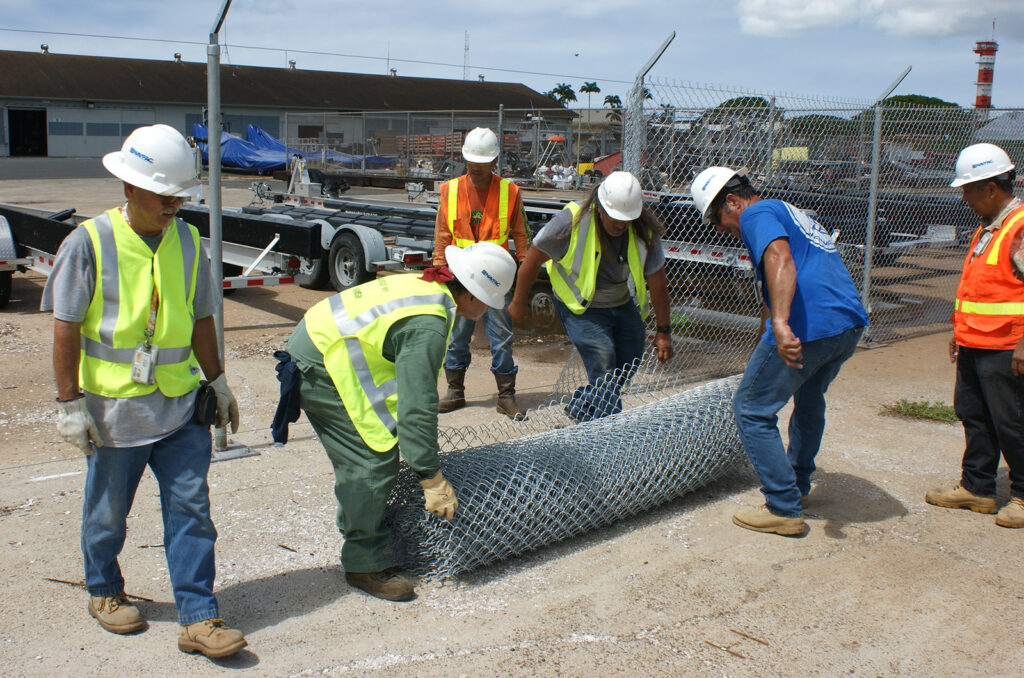As temperatures rise during the summer months, construction workers, agricultural workers, and other tradesmen, such as fence installers, are at a higher risk of dehydration and heat-related illnesses along with the elderly and athletes, according to the Cleveland Clinic. Being prepared for extreme heat and knowing the signs of dehydration and heat stroke can be crucial in keeping outdoor workers safe. This article provides essential information regarding safety during extreme heat conditions, knowing the signs of dehydration, and effects heat-related illnesses can have.

Key Takeaways:
- Drink before you feel thirsty
- Knowing the signs of dehydration and what to do when it occurs
- Heat-related illnesses can have long-term effects such as cardiovascular, neurological, respiratory, kidney failure, and mental health problems
- Institutional and legislative work bans during extreme heat conditions
Keeping Cool in Extreme Heat
Preventing Dehydration and Signs to Watch For

The CDC recommends that workers need to hydrate before, during and after working in extreme temperatures. It is recommended to drink before feeling thirsty because then it is too late to replenish the fluids lost through sweat. It is better to drink small amounts of water or sports drinks throughout the day, every fifteen to twenty minutes, rather than drinking copious amounts of water after you’re already dehydrated.
Another way to prevent dehydration is avoiding caffeinated drinks such as soda, coffee, and even alcohol. Starting labor or any physical activity before or after the midday heat. Taking breaks in the shade when possible and stopping work at the first signs of lightheadedness, dizziness, or fatigue. Other signs of dehydration include:
- muscle cramps;
- headaches, confusion, or delirium;
- flushed skin;
- high heart rate with low blood pressure;
- constipation;
- not sweating;
- less urination;
- thirst;
- irritability;
- dry mouth and or a dry cough;
- heat intolerance, or chills;
- swelling in the feet;
- warm to the touch skin;
- not being hungry but craving sugar; and
- urine that is darker in color.
The Red Cross recommends if a person is suffering heat exhaustion to move them to a cool place; loosen tight clothing; cool the body using wet cloths, misting, fanning, or a cool bath; sip water slowly; and call for help if their symptoms continue for an hour, they start to vomit, or confusion develops. If they are already suffering heat stroke, call for medical assistance first, bring down their body temperature but do not give the person anything to drink.
Long Term Effects of Heat-Related Illnesses
Cerebral edema or swelling of the brain is caused when your body pulls too much water into your cells after being dehydrated, according to the Mayo Clinic. This can be fatal when brain cells are affected. Severe dehydration can also cause seizures caused by low levels of electrolytes such as potassium and sodium. This can lead to involuntary muscle contractions and sometimes a loss of consciousness.
The person can also go into hypovolemic shock or low blood volume which is caused by a sudden drop in blood pressure and a drop in the amount of oxygen in your body. This is one of the most serious and sometimes life-threatening complications of dehydration according to the Mayo Clinic. Kidney failure is also a potentially life-threatening problem because the kidneys are unable to remove excess fluids from the bloodstream.
An Institutional Need for Extreme Heat Protections
With the rising temperatures across the country and around the world, there is an institutional need for work bans in cases where the wet-bulb globe temperature (WBGT) does not allow for safe working conditions. According to NPR, California was the first to establish legislation that employers provide water, shade, and rest breaks in 2006. After a deadly heat wave in the Pacific Northwest in 2021, Washington and Oregon also implemented worker protections from extreme heat.
In April 2024, Florida governor Ron DeSantis signed a law that prevented “cities or counties from creating protections for workers who labor in the state’s often extreme and dangerous heat,” according to NPR. This law blocked protections from being implemented in cities and counties across the state.
Between June and August of 2023, at least five people died of heat-related illness while on the job, according to a press release from New York AG Letitia James office regarding a petition for heat protections for outdoor workers. Including a postal worker in Dallas died of heat stroke while delivering mail in June and a warehouse worker in a distribution center that didn’t have A/C in Memphis died in August.
Despite warning, Americans went to work without knowing the protective measures they could take to prevent heat-related illness such as plenty of drinking water, breaks in a cool location, and reduction of strenuous work during the hottest portions of the day. Occupational workers should also be able to freely report employers who they feel are not taking serious measures to protect their employees from dangerous conditions.
Conclusion
Now that you know the symptoms of dehydration and how to help someone suffering from heat-related illness, hopefully, you can feel confident and safe working in extreme conditions. Workers, including fence installers, are encouraged to have water bottles on hand and bring a little extra for longer shifts. There is still an institutional need for training in these types of situations, not just first aid. This summer is expected to be hotter than last year, putting workers at even greater risk for heat-related illness, injury, and death.

